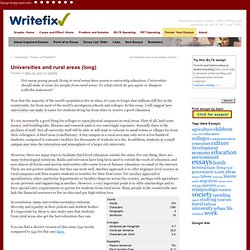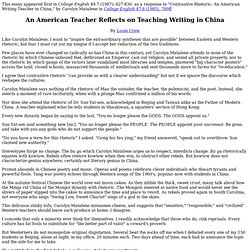Discourse patterns
> Vr..oem
> Cross cult dif in edu
How Your Body Language Shapes Who You Are. Second Language Writing and Research: The Writing Process and Error Analysis in Student Texts. Second Language Writing and Research: The Writing Process and Error Analysis in Student Texts Johanne Myles Queen's University <jbm2@post.queensu.ca> Abstract Academic writing requires conscious effort and much practice in composing, developing, and analyzing ideas.

Students writing in a second language are also faced with social and cognitive challenges related to second language acquisition. L1 models of writing instruction and research on composing processes have been the theoretical basis for using the process approach in L2 writing pedagogy. Introduction The ability to write well is not a naturally acquired skill; it is usually learned or culturally transmitted as a set of practices in formal instructional settings or other environments.
This paper explores error in writing in relation to particular aspects of second language acquisition and theories of the writing process in L1 and L2. Models of L1 and L2 Writing The Sources of Error in L2 Writing: Social and Cognitive Factors. Universities and rural areas (long)
Not many young people living in rural areas have access to university education.

Universities should make it easier for people from rural areas. To what extent do you agree or disagree with this statement? Now that the majority of the world’s population live in cities, it’s easy to forget that millions still live in the countryside, far from most of the world’s prestigious schools and colleges.
In this essay, I will suggest how universities can make it easier for students living far from cities to receive a good education. It’s not necessarily a good thing for colleges to open physical campuses in rural areas. However, there are many ways to facilitate third level education outside the cities. In conclusion, many universities nowadays welcome diversity and equality in their policies and student bodies.
Parts of an Essay. Essays, like sandwiches or burgers, are divided into different parts.

These parts are the: IntroductionBodyConclusion. Chinese Communication Studies: Contexts and Comparisons. Writing2.richmond.edu/training/383/383restricted/severino.pdf. Writing2.richmond.edu/training/383/383restricted/severino.pdf. An American Teacher Reflects on Teaching Writing in China. This essay appeared first in College English 49.7 (1987): 827-830. as a response to "Contrastive Rhetoric: An American Writing Teacher in China," by Carolyn Matalene in College English 47:8 (1985), 789ff By Louie Crew Like Carolyn Matalene, I want to "inspire the extraordinary syntheses that are possible" between Eastern and Western rhetoric, but fear I must cut out my tongue if I accept her reduction of the two traditions.

Few places have ever changed so radically as has China in this century, yet Carolyn Matalene attends to none of the rhetoric by which Chinese unbound feet, dethroned an Emperor, cast out religion, and seized all private property, nor to the rhetoric by which gangs of the victors later vandalized most libra�ries and temples, plastered "big character posters" across the land, closed schools, massacred thousands of intellectuals and sent thousands more to farms for "re-education.
"
O is for Othering. ‘Othering’ is the way members of one social group distance themselves from, or assert themselves over, another by construing the latter as being fundamentally different (the ‘Other’).

It is a term that is associated with discourses of colonialism, and, in particular, with the work of Edward Said. In his influential book Orientalism, (1995: 332) Said wrote: ‘The development and maintenance of every culture requires the existence of another different and competing alter ego. The construction of identity… whether Orient or Occident, France or Britain… involves establishing opposites and otherness whose actuality is always subject to the continuous interpretation and reinterpretation of their differences from us‘. Patterns of written discourse (after Kaplan 1966) Click to enlarge A discussion of otherness arose last week in my MA TESOL discourse analysis class. Such a view seems overly reductive in this day and age. Kramsch (1998: 63) would seem to confirm Eggins’ point:
Www.fresno.k12.ca.us/divdept/titlevii/discourse.pdf.





